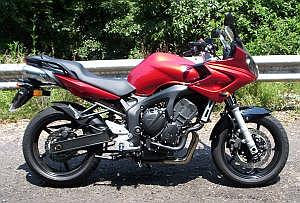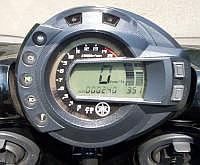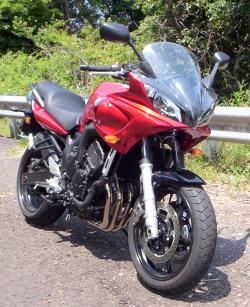 It also rides well. The suspension is quite compliant and soaks up smaller bumps pretty well, although it gets caught out a bit on larger bumps. Still pretty good though, especially for this size bike.
It also rides well. The suspension is quite compliant and soaks up smaller bumps pretty well, although it gets caught out a bit on larger bumps. Still pretty good though, especially for this size bike.
 Right from when you first take off and ride down the street it feels very low-geared. But out on the open road is where you really notice it. Top gear (of 6) runs at just under 20kph / 1,000rpm. So at a cruising speed of around 110 it’s doing 6,000rpm. That feels pretty buzzy and makes touring a little unpleasant. I suppose Yamaha figure that with 14,000 revs to play with the gearing is high enough; after all, at the redline it’d be doing over 270kph! But as I’ve said, it feels pretty buzzy at higher revs, and the high-rev cruising isn’t all that pleasant. It’s strange really. The old XJ Seca was geared at around 21kph / 1,000rpm in top and settled into a very relaxed cruise at 110 – 120, with the tacho hanging a bit over 5,000rpm. But cruising never felt relaxed on the FZ, which kind of limits – to me anyway – it’s potential as a tourer.
Right from when you first take off and ride down the street it feels very low-geared. But out on the open road is where you really notice it. Top gear (of 6) runs at just under 20kph / 1,000rpm. So at a cruising speed of around 110 it’s doing 6,000rpm. That feels pretty buzzy and makes touring a little unpleasant. I suppose Yamaha figure that with 14,000 revs to play with the gearing is high enough; after all, at the redline it’d be doing over 270kph! But as I’ve said, it feels pretty buzzy at higher revs, and the high-rev cruising isn’t all that pleasant. It’s strange really. The old XJ Seca was geared at around 21kph / 1,000rpm in top and settled into a very relaxed cruise at 110 – 120, with the tacho hanging a bit over 5,000rpm. But cruising never felt relaxed on the FZ, which kind of limits – to me anyway – it’s potential as a tourer.
 So, to sum up, it’s a mid-size bike that’s comfortable to ride and good fun through the twisties; but it’s not a long-distance tourer. The pity is that if it had a bit more power (which wouldn’t be hard to achieve, considering where the engine came from!) and higher gearing, I think it could be! Although obviously it could never be a serious competitor to the likes of the Honda, the Triumph, and the Ducati etc.
So, to sum up, it’s a mid-size bike that’s comfortable to ride and good fun through the twisties; but it’s not a long-distance tourer. The pity is that if it had a bit more power (which wouldn’t be hard to achieve, considering where the engine came from!) and higher gearing, I think it could be! Although obviously it could never be a serious competitor to the likes of the Honda, the Triumph, and the Ducati etc.
Ridden 2007
P.S. The FZ6 was up-dated about mid-way through 2007. Changes include modifications to the fuel-injection, exhaust emissions, brakes, and frame dimensions (although wheelbase is unchanged). Probably the best news though, is that the instruments have been replaced with standard analogue type tacho and digital speedo. Much better! Click the button below to go to the test of the new model.



